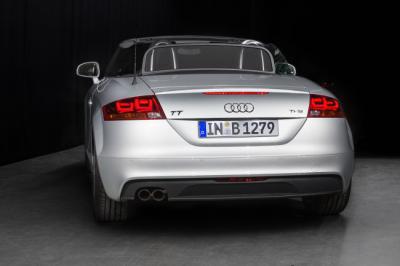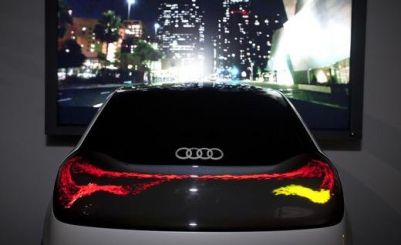Audi, Philips, Automotive Lighting, Merck and the University of Cologne successfully concluded an OLED research project (called OLED 3D), and developed the world's first large-area 3D OLED car rear lighting panels and installed a prototype on an Audi TT.

A 3D OLED means that the OLEDs have a curved surface - not just in one direction. These are glass based panels. It's not flexible glass (like Corning's Willow glass), it's the regular glass Philips are using in their regular OLEDs, but curved. The material used (made by Merck) are soluble, and the production process is described as "web printing" by Philips (I'm not sure what is meant by that).
Those OLEDs are transparent (in some parts), and Audi stacked several of them over each other, which makes for a unique impressions of light emerging from within. Philips wouldn't reveal any technical details on those OLEDs (lifetime, efficiency, etc) - but this is just a concept so they didn't focus on the light quality or features at that time.
The OLED 3D project was funded by the German government (â¬5.7 million). The project was led by Philips. As part of the project, they developed new crosslinkable red OLED materials which enabled producing soluble OLEDs in multiple layers on formed glass using "wet chemistry". Crosslinking means bonding (or linking) several polymer chains together - so that the molecules tend to hold together better and longer, and this is useful when you apply several soluble OLED layers on on top of the other as it prevents the different layer molecules from mixing. The crosslinking was achieved by heating the materials in a "special way".
I think that if Philips are calling this cross linking, it also means that the material themselves are polymers (PLEDs). I don't have confirmation on this though.
Philips also produced the actual panel prototypes. They had to adapt their production process for the 3D OLEDs, mainly the glass substrate production and the vacuum OLED deposition, encapsulation and electrical contacting.
Audi has been playing with OLED lighting for cars for a while now. In 2012 they unveiled three OLED designs, including the rear-mounted "swarm" which uses tiny OLED lighting panels to create a beautiful large display. Audi has been mostly collaborating with Philips on that, but they also showed some designs using OSRAM made OLEDs.
 Audi's OLED swarm
Audi's OLED swarm
Audi also recently installed a new OLED installation in one of their conference rooms in their HQ at Ingolstadt. The installation includes 15 OLED luminaires, each containing 36 Philips Lumiblade GL350 OLED panels for a total of 540 OLED panels and a total light output of 58,000 lumens.

